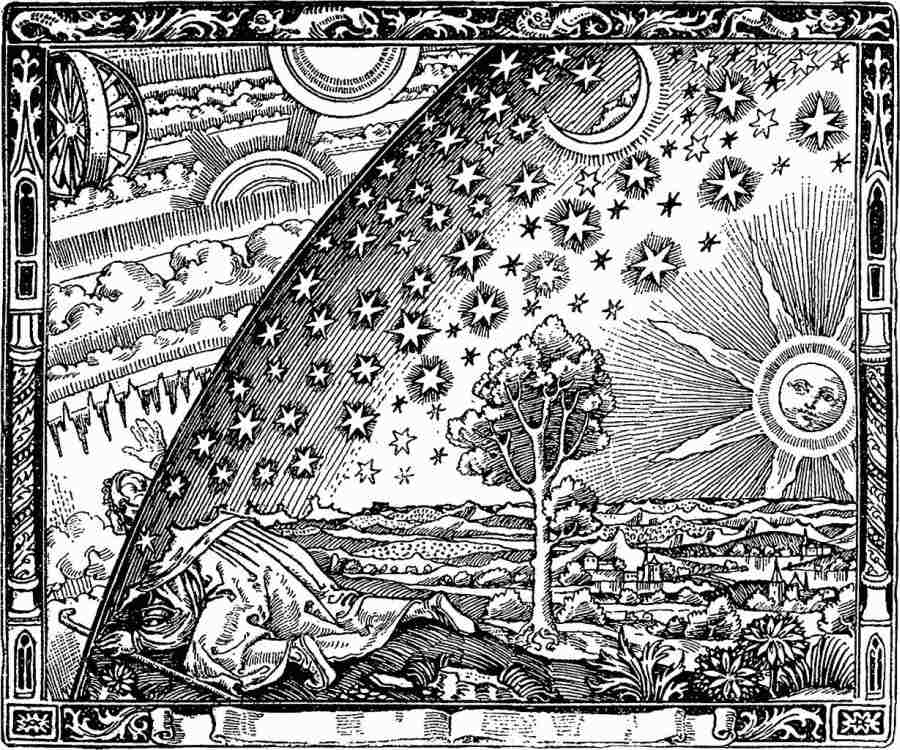 |
|
|
The original version of this document is also available in german.
The translation of this englisch version is work in progress.
The original document is and will be extended, as can be seen with the section 1.7 More Notes.
C.S. has not only made an abstract version of a watch model by blackening the watchface and removing the brand logo on the crown, but created within the scope of the artistic creation a wirst-worn ontologic instrument with a smart wristband.
The ontologic instruments respectively Ontoscopes and their reflection should not be regarded in isolation, but have to be set in relation with older works (see section 1.1) and discussed in the context of three main activities of C.S., namely
1.1 Relation to older works
The following and very brief summary should impart a part of the artistic activity of C.S. in the different relevant areas, which are specifically fundamental and inspiring for the realisation of the multimedia work of art "Cyberplano" discussed here besides the own fields of activity (see the sections 1.2, 1.3, and 1.4).
On the one hand the movement of arts:
- Minimalism,
- Suprematism and the abstraction respectively the geometric-technical formal principle of the Constructivism accompanying therewith and also
- Futurism,
have to be named, that are characteristic for the many works of the multimedia work of art series "Schwarzes Rechteck==Black Rectangular" and "Schwarzer Kreis==Black Circle" or also "Schwarze Anzeige==Black Display" of C.S..
On the other hand the following older works are used and briefly described in the following sections for a better understanding:
- the work "Utriusque cosmi maioris scilicet et minoris Metaphysica, physica atque technica Historia" ("Metaphysik und Natur- und Kunstgeschichte beider Welten, nämlich des Makro- und des Mikrokosmos==Metaphysical, and Natural and Art History of both Worlds, namely the Macrocosm and the Microcosm or Metaphysical, physical, and technical History of the two Worlds, namely the Greater and the Lesser") of Robert Fludd of the year 1617-1619,
- the image "Schwarzes Quadrat==Black Square" exhibited the first time in the year 1915 and the image "Schwarzer Kreis==Black Circle" of Kasimir Malewitsch,
- "Flammarion Engraving" presented by Camille Flammarion the first time in the year 1888 in the work "L'Atmosphère: météorologie populaire" ("The Atmosphere: popular meteorology"), and also
- the Goldene Compass of the first part with the title "Northern Lights" of the fantasy-trilogy "His Dark Materials" of Philip Pullman and publicated the first time in the year 1995.
1.1.1 Robert Fludd
In the first volume of "Metaphysical, and Natural and Art History of both Worlds, namely the Macrocosm and the Microcosm" of his story of the macrocosm the english doctor and natural philosopher Robert Fludd has visualized a genesis, which starts with the archetype or primary image of the hyle, the equivalent to the nothing or void, as a black rectangular (see cover page).
Hyle (greek substance or substrate, matter) appears as philosophical term inter alia in the context of the aristotelian metaphysics and physics, where it is used within the conceptual pair 'form or shape' and 'substance or substrate'. Hyle is there the first underlying bare of all determination (see Werner Marx: "Einführung in Aristoteles Theorie vom Seienden==Introduction in Aristotle's Theory of the Being", Freiburg i. Br., 1972, p. 40), the formable matter, the material, the 'primary matter', that by the technical, which means the human work, takes on a specific gestalt.

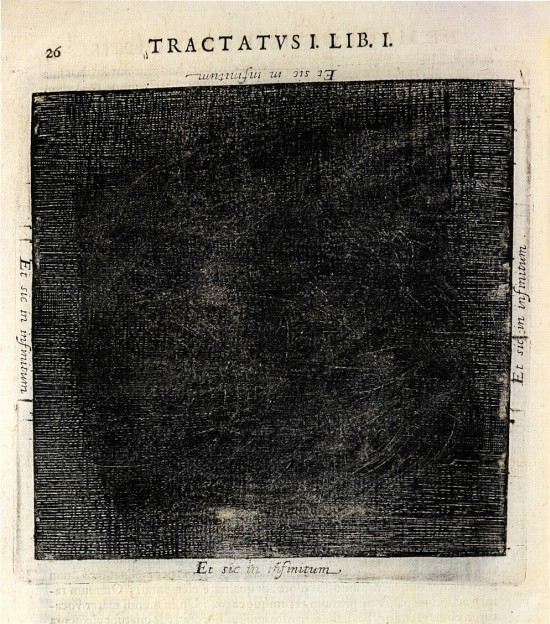
Cover page "Metaphysical, and Natural and Art History of both Worlds, namely the Macrocosm and the Microcosm"
1.1.2 Kasimir Malewitsch
"When I made the desperate attempt in 1913 to liberate the art from the weight of the things, I exhibited a painting, that was not more than a black square on a white background ... It was not an empty square, that I showed, but rather the sentiment of the non-objectivity.", Kasimir Malewitsch
A great number of art historians, curators and critics refer to the painting "Black Square" as one of the fundamental works of the modern art and the abstract art in the western tradition of painting in general.
The painting "Black Circle" seamlessly joined the concept of the painting "Black Square" and nimmt zur Darstellung in accordance with the Suprematism as well as in accordance with the Constructivism a different geometric figure, namly a circle.
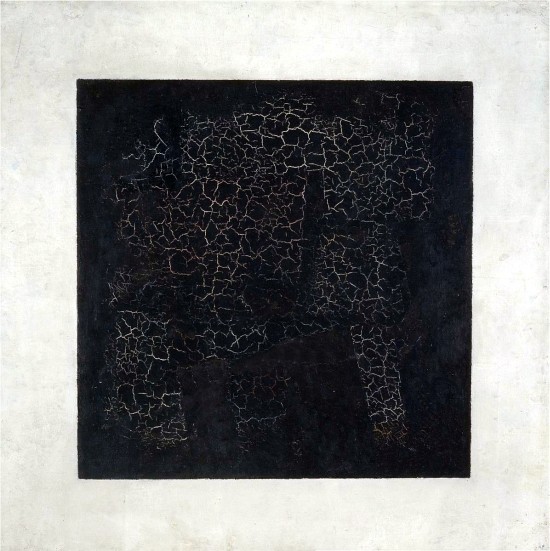
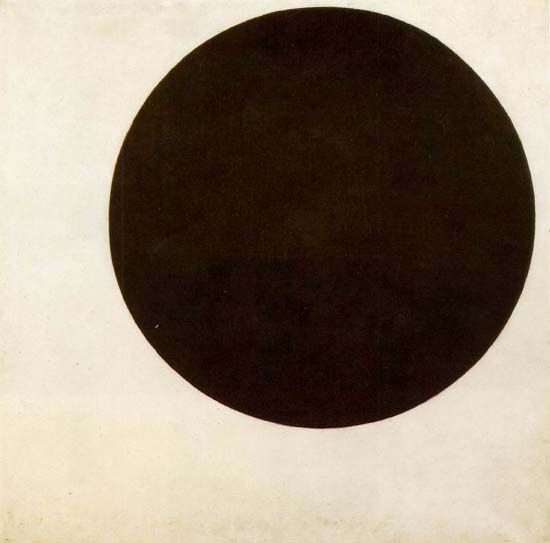
Black Square 1915 and Black Circle 1915
1.1.3 Camille Flammarion
The Flammarion Engraving is the work of an unknown artist. The wood engraving turned up the first time 1888 as illustration in the chapter "La forme du ciel" ("The shape of the sky") of the popular scientific book "The Atmosphere: Popular Meteorology" of the French author Camille Flammarion.
Die Illustration zeigt eine hügelige und bergige Landschaft mit mehre- ren Städten an einem See, überspannt von einem als gekappter Viertelbogen aufgeschnitten gezeigtem hemisphärischen Himmel mit strahlender Sonne, sichelförmigem Mond und zahlreichen Sternen, sowie im Vordergrund links vor einem Baum auf einer Anhöhe einen knienden Beobachter, der nach links die Himmelssphäre durchdringt und mit den Schultern in dieser steckt, etwa an der Stelle, wo die Sphäre des Himmels dem Rand der Oberfläche der Erde anliegt. Von einer anscheinend flachen Erdscheibe blickt diese Person auf mehrere kreisähnliche, voneinander abgesetzte und aufeinanderfolgende Streifen oder Schichten, die flammenförmig und wolkenförmig ausgestaltet sind und in oder auf denen zwei Scheiben und ein Paar ineinandergefügter Räder zu liegen scheinen.
The caption of the image reads translated:
"A missionary of the Middle Ages tells that he had found the point where the sky and the earth touch ...", Camille Flammarion: L'atmosphère, Paris, 1888, page 163
The image illustrates a text passage of the facing page: "... Ein naiver Missionar des Mittelalters erzählt sogar, dass er auf einer seiner Reisen auf der Suche nach dem irdischen Paradiese den Horizont erreichte, wo der Himmel und die Erde sich berühren, und dass er einen gewissen Punkt fand, wo sie nicht verschweißt waren, wo er hindurch konnte, indem er die Schultern unter das Himmels- gewölbe beugte. ...", Camille Flammarion: L'atmosphère, Paris, 1888, Seite 162
Die zwei ineinandergefügten und in sich selbst laufenden Räder werden auch als den Merkaba, den "Thronwagen" der Vision des Propheten Ezechiel gedeutete. Moderne Betrachter erwarten kein Gottesbild im Himmel und sehen hier das "Universum", "Geräte", einen "himmlischen Mechanismus" und dergleichen (Senger, 2002, S. 331, Anmerkung 90 nennt Beispiele) oder den "unbewegten Beweger" oder "Primum Movens", was als Vorstellung auf Aristoteles zurückgeht.
1.1.4 Philip Pullman
The Golden Compass is an alethiometer (Greek aletheia = truth, reality and metron = measure, measurement), thus an instrument, which always tells that one human, who is able to read it (among also the protagonist Lyra), the truth.
An alethiometer is similar to a golden pocket watch or a compass and has 4 hands and 36 symbols, which are circumferentially arranged at the border. When operated properly the alethiometer provides answers on arbitrary questions. For this purpose the three hands are set with the aid of the small cogs as with a watch on the corresponding symbols and focuses on the question. The fourth hand now runs several times in a circle and stops at those symbols, which point to the answer. Thus the symbol of an ant stands for diligence among other things.
Because there are multiple levels of meaning for each symbol, much exercise is required for being able to interpret them correctly. Usually, alethiometrists must use reference works for this.
However, the protagonist Lyra has the gift to understand the alethiometer instinctively in a kind of trance. Later in the trilogy she even has the gift to feel "different moods" of the alethiometer, for example when she ask too personal questions about her friend Will to the alethiometer.
1.2 Pervasive or Ubiquitous Computing
Wie oben schon gesagt wurde, beschreibt C.S. nicht nur die Verän- derung der Gesellschaft im Rahmen des durchdringenden Rechnens oder allgegenwärtigen Rechnens (in englisch Pervasive Computing oder Ubiquitous Computing), sondern transformiert dementsprechend auch alltägliche Objekte in digitale Objekte, wie in diesem Fall eine klassische mechanische Armbanduhr in ein Ontologisches Gerät oder Ontologisches Instrument beziehungsweise ein am Körper getragenes Ontoskop, ein am Körper getragener Computer oder eine Smarte Uhr.
Dementsprechend sind die Abbildungen Teile des hier diskutierten multimedialen Kunstwerks, das den Titel "Cyberplano" trägt und ge- meinsam mit ungefähr 50 oder 60 solcher Arbeiten die multimedialen Kunstwerkserien "Schwarzes Rechteck" und "Schwarzer Kreis" oder zusammengefasst auch "Schwarze Anzeige" bildet (siehe auch Abschnitt 1.4.6).
1.3 Multimediatechnologien und -systeme
Ein weiteres Hauptbetätigungsfeld von C.S. sind multimediale Technologien und Systeme, die aufgrund ihrer Progressivität nicht nur gesellschaftsverändernd sind, sondern auch die gesellschaftli- chen Diskussionen über mögliche zukünftige Entwicklungen sowie Chancen und Risiken für das einzelne Individuum als auch für die gesamte Gemeinschaft beginnen. Diese Aspekte machen die multimedialen Arbeiten von C.S. grundsätzlich zu Kunstobjekten.
Ein besonderer Unterbereich umfasst die tragbaren oder anziehbaren Computer, insbesondere die hier relevanten Klassen der
- am Handgelenk getragene Computer (in englisch Wristworn Computer) mit elektronischer Anzeige für die Darstellung von veränderlichen visuellen Informationen, der teilweise inkorrekt durch das Publikum auch als sogenannte Smarte Uhr (in englisch Smartwatch) bezeichnet wird und als Smartes Mobiltelefon am Handgelenk (in englisch Wristworn Smartphone) beschrieben wird,
- Smarten und Intelligenten Kleidungen (in englisch Wearable Computer, Smart Wear und Intelligent Raiment) sowie
- Ontologic devices or Ontologic Instruments of C.S. (see Abschnitt 1.4.6 für weitere Informationen), die ähnlich einem am Handgelenk getragenen Computer, aber auch einem in der Hand gehaltenen Computer (in englisch Handheld Computer oder Palm Computer), Taschencomputer oder Smarten Mobiltelefon sowie einer Smarten (Daten)Brille (siehe Ontoscope) sind.
Eine charakteristische Eigenschaft der am Handgelenk getragenen Computer und Ontologischen Instrumente ist das optionale elektro- nische Armband, das auf der einen Seite die Funktionalität dieser Geräte insbesondere durch eine größere elektrische Energieversor- gung steigert und auf der anderen Seite andere Konstruktionsweisen zulässt, wie der ultraflachen Bauweise, die auch in einigen der diskutierten Abbildungen des Ontologischen Instruments eindeutig erkennbar ist.
Da die Umsetzung der multimedialen Kunstwerke praktisch immer Pionierarbeit darstellt, muss C.S. die notwendigen Techniken und Technologien entweder selbstentwickeln oder Vorlagen von externen Entitäten ableiten, verändern und sogar neu entwickeln, insbeson- dere die Hardware und Software aber auch die Algorithmen.
So kann man zum Beispiel eben nicht einfach ein Uhrengehäuse einer mechanischen Armbanduhr nehmen und einen Miniaturcomputer samt einer Anzeige und einer Batterie einbauen. Wenn dann auch noch ein multimediales Kunstwerk eine spezielle externe Formgebung benötigt, die den inneren Ausdruck des Werkes auch nach außen darstellen soll, wie zum Beispiel im Fall der "Cyberplano", dann kann man direkt bei Null anfangen und alles selber realisieren.
1.4 Ontonik und Ontologik
Ein besonderer Bereich der Arbeit von C.S. ist neue Einsichten auf das Universum, über die Existenz, die Einteilung des Seiende, die Grundstrukturen der Wirklichkeit und der Möglichkeit sowie die Erkenntnis und die Wahrheit und so weiter sowohl auf den metaphy- sischen beziehungsweise ontologischen und philosophischen als auch auf den physikalischen und technischen Ebenen zu erlangen, aufzu- zeigen und gegebenenfalls einem breiteren Publikum in geeigneter Art und Weise nutzbar zu machen.
Wie es unter anderem aus den Inhalten von den Web-Auftritten deutlich und unmissverständlich hervorgeht, siehe zum Beispiel die Web-Auftritte OntomaX, Ontoscope, iRaiment und OntoLinux, beschäftige sich C.S. sowohl privat, künstlerisch als auch unterneh- merisch mit dem selbstgeschaffenen Feld der Ontonik und seinem Teilgebiet der Ontologik.
Dabei ist insbesondere die Ontologie die leitende Disziplin, wie man an der folgenden Begriffsdefinition und -erklärung sehen kann:
Definition Ontonik - Ontonics
"Erkenntnisse der Ontologie für die Technik nutzbar machen", Christian Stroetmann 1995
Erklärung Ontologik - Ontologics
"Erkenntnisse der Ontologie durch Anwendung der Logik für die Technik nutzbar machen", Christian Stroetmann 1995
Als theoretische und praktische Ergebnisse der Arbeit in diesem Bereich sind vor allem die Entwicklungen von
- der Null-Ontologie O#,
- dem Ontologischen System mit einem Calibre oder Kaliber und weiteren Eigenschaften als auch
- der Ontologischen Geräte oder Ontologische Instrumente,
die unter anderem als Multimediatechnologien und -systeme realisiert werden (siehe Abschnitt 1.3), zu nennen.
1.4.1 Ontologisches System
Die in der Ontologie, Ontonik und Ontologik diskutierten Themen sind wiederum für ein anderes hier relevantes Hauptkunstwerk mit dem Titel "Ontologisches System" grundlegend (in englisch Ontologic System, kurz OS, siehe auch die Web-Auftritt von Ontologics OntoLinux).
Das OS ähnelt einem universalen Betriebssystem, das auf der einen Seite unter anderem
- die Universelle Turing Maschine (kurz UTM) von Alan Turing,
- das Evolutionäres Betiebssystem (in englisch Evolutionary Operating System, kurz EvoOS, siehe Das Proposal und Der Prototyp), das insbesondere den Anfangszustand eines kybernetischen Systems aus Sicht
- der Algorithmischen InformationsTheorie (kurz AIT),
- des künstlichen Lebens (in englisch Artificial Life, kurz AL) und
- der künstlichen Embryologie (in englisch Artificial Embryology, kurz AE) als auch
- der SoftwareTechnologie (kurz SwT)
untersucht, und
- viele weitere philosophische, physikalische und informations- technische Erkenntnisse und Entwicklungen als Grundlagen hat
und auf der anderen Seite mit oder auf elektronischen Geräten ausgeführt wird, wie etwa den
- Ontologischen Geräten oder Ontologischen Instrumenten, insbesondere den Ontoskopen,
- am Handgelenk getragenen Computern mit Display sowie
- Smarten Uhren.
Das OS
- basiert auf der von C.S. eingeführten Null-Ontologie O# (siehe Abschnitt 1.4.2),
- wird auch als eine Singularität bezeichnet (siehe Abschnitt 1.4.3),
- besitzt zudem auch das Calibre oder Kaliber von C.S. (siehe Abschnitt 1.4.4),
- definiert die gemischte Realitätsumgebung (in englisch Mixed Reality Environment (MRE)) OntoVerse (kurz OV) von C.S. (siehe Abschnitt 1.4.5) und
- wird durch Ontologische Geräte oder Ontologische Instrumente realisiert und auf diesen ausgeführt (siehe Abschnitt 1.4.6), die wiederum auf multimedialen Techniken und Technologien basieren, insbesondere multimedialen Systemen und Umgebungen (siehe Abschnitt 1.3).
1.4.2 Null-Ontologie
Bei der Arbeit in den Bereichen der Ontologie als auch der Ontonik und der Ontologik stellte C.S. relativ schnell fest, dass es auch hier keine Abgrenzungen im Bezug auf einen Anfangs- und einen Endzu- stand gibt. Um solche Zustände jedoch diskutieren und handhaben zu können, wurden zum Beispiel als Revolutionen in der Mathematik
- die Null,
- die Infinitesimalrechnung durch René Descartes und Bonaventura Cavalieri als auch Gottfried Wilhelm Leibniz und Isaac Newton sowie
- das Fraktal durch Benoît Mandelbrot
eingeführt.
Diese Überlegungen übertrug C.S. auf den Bereich der Metaphysik beziehungsweise Ontologie und damit auch auf die Felder der Ontonik und der Ontologik mit der Einführung der Null-Ontologie O#. Dabei steht das Symbol O# unter anderem für ein Nichts beziehungsweise ein Fraktal, eine Art Hyle oder 'Urstoff' von Raum und Zeit (siehe Abschnitt 1.1.1), eine Singularität (siehe Abschnitt 1.4.3), eine Reflektion zwischen einem Kreis und einem Quadrat (oder einem Rechteck), das sich aus vier Linien ergibt, und andere Dinge.
1.4.3 Singularität
Wie man auch auf dem Web-Auftritt von dem OS OntoLinux erfahren kann, bezeichnet C.S. ein OS auch als eine Singularität, die wiede- rum mit einer Vielzahl an Konzepten, Techniken und Beobachtung in Verbindung steht, insbesondere mit möglichen Anfangs- und Endzuständen des Universums sowie schwarzen Löchern.
Im Folgenden wird aus einer bekannten Online-Enzyklopädie der Eintrag zum Begriff Singularität zitiert:
Singularität (lateinisch singularis, in deutsch einzeln, vereinzelt, eigentümlich, außerordentlich; Adjektiv singulär) bezeichnet:
im Allgemeinen
- eine Vereinzeltheit, Einzigartigkeit oder Einzähligkeit, siehe Unikat
- Singularität (Systemtheorie), ein Punkt, in dem auf eine kleine Ursache eine große Wirkung in der Systementwicklung folgt
- Singularität (Robotik), bestimmte Raumpunkte, die durch unendlich viele Achsstellungen erreicht werden können, siehe Industrieroboter Achskonfiguration
- Singularität (Geographie), ein geographisches Objekt, das sich deutlich von seiner Umgebung absetzt, jedoch für das Grundgefüge seiner umgebenden Landschaft nicht wesentlich ist
- Singularität (Meteorologie), eine Wetterlage, die zu einer bestimmten Zeit im Jahresverlauf mit hoher Wahrscheinlichkeit auftritt
- Technologische Singularität, in der Futurologie den Zeitpunkt, ab dem Maschinen sich selbst verbessern können und so den technischen Fortschritt massiv beschleunigen
in der Mathematik
- eine Definitionslücke einer Funktion
- eine isolierte Singularität einer holomorphen Funktion
- eine Relation zwischen zwei Maßen, siehe Singularität (Maßtheorie)
- in der algebraischen Geometrie Algebraische Varietät Singularitäten
- eine Koordinatensingularität
in der Astronomie
- allgemeine Gegebenheiten, unter denen physikalische Gesetze nicht definiert sind, darunter:
- Schwarzes Loch, eine Krümmungssingularität der Raumzeit
- den Zustand des Universums beim Urknall
- den Zustand des Universums beim Big Crunch
- den Zustand des Universums beim Big Rip
- eine nackte Singularität
Weitere Einsichten im Zusammenhang mit schwarzen Löchern gibt C.S: unter anderem auf der Web-Seite des Raumschiffkonzepts "Twin Ion Engine Royal (TIE-R) LightSwift" auf dem Web-Auftritt von Style of Speed.
1.4.4 Calibre oder Kaliber
Das Calibre oder Kaliber des Ontologischen Systems:
- bezieht sich auf Raum und Zeit im Kontext einer metaphysi- schen beziehungsweise ontologischen und philosophischen als auch physischen und technischen oder kurz gesagt ontoni- schen Betrachtung des Universums,
- hat teilweise Flammarions Holzstich (siehe Abschnitt 1.1.3), insbesondere das Himmelswerk mit den ineinandergefügten und in sich selbst laufenden Rädern sowie dem Übergang oder die Brücke zwischen Himmel und Erde, und den Goldenen Kompass (siehe Abschnitt 1.1.4) als inspirierende Vorlagen,
- basiert eben nicht mehr auf einer realen Feinmechanik, sondern auf einer sozusagen virtuellen universellen Mechanik und kann als multidimensionales digitales Getriebe beschrieben werden, dass Funktionen von
- abstrakten Maschinen,
- virtuellen Maschinen,
- Betriebssystemen,
- softwareagentenbasierten Systemen (inklusive agentenbasierter Systemen auf der Grundlage der Multidimensionalen Linearen Temporalen Logik (MLTL)) und
- anderen Softwaresystemen gemäß des Ansatzes "Gears by Software" ("Zähnräder durch Software")
auf der einen Seite sowie
- realen hardwarebasierten digitalen Systemen
auf der anderen Seite umfasst
und
- repräsentiert unter anderem auch eine dynamische Weltformel oder eine universelle Theorie von Allem (in englisch Theory of Everything, kurz ToE).
In dieser Hinsicht könnte man auch den Begriff Neue Horologie oder Horologie des 21. Jahrhunderts wählen, um das von dem Calibre ermöglichte neue Studium der Zeitmessung zu bezeichnen. Jedoch ist diese Bezeichnung nicht ganz zutreffend, da ja auch der Raum gemäß Albert Einstein et al. und nicht nur die Zeit sowie die Onto- logie durch das OS und seinem Calibre miteinbezogen werden. Siehe auch noch einmal die Kerne des Zwillingsionenantriebes des Raum- schiffkonzeptes "Twin Ion Engine Royal (TIE-R) LightSwift" von Style of Speed, das auch auf dem Ontologischen System basiert, sowie den Vergleich mit der ähnlichen, weil abgeleiteten Arbeit "H9 Reduction" von Beat Haldimann in Abschnitt 1.5.1.
Letztendlich ist es nicht möglich das Calibre oder Kaliber von C.S. mit zum Beispiel einem Uhrwerk beziehungsweise klassischem Kaliber in Übereinstimmung zu bringen, da hierfür der künstlerische als auch ontonischer Ansatz bei weitem alles übersteigt, was mit ingenieurs- mäßigem Handeln gemeinsam hat.
1.4.5 OntoVerse
Das Ontologisches System (siehe Abschnitt 1.4.1) umfasst auch ein Kontinuum der gemischten Realität (in englisch Mixed Reality (MR)), das
- das gesamte Spektrum der Realität, der angereicherten Realität (in englisch Augmented Reality (AR)) und der virtuellen Realität (in englisch Virtual Reality (VR)) abdeckt und
- die Grundlage für das Ontologische Universum (in englisch Ontologic Universe, kurz OntoVerse oder OV) ist, das wiederum als ein perfektes Glaubenssystem und somit als die neue Realität bereits eingeführt wurde.
Das OV umfasst somit auch den sogenannten Cyberspace.
1.4.6 Ontologisches Instrument
Ein tragbares oder anziehbares Gerät, insbesondere ein am Handgelenk getragener Computer oder lediglich eine Smarte Uhr, ist unter anderem als ein
- Darstellungsmittel für ein Ontologisches Gerät oder Ontologisches Instrument sowie
- System für die dynamische Ausführung des Ontologisches Systems und
- anfassbare Benutzerschnittstelle des Ontologischen Systems
ausgezeichnet geeignet.
Hierbei bezieht sich der Begriff Uhr hauptsächlich auf die ähnliche äußere Form sowie die Art und Weise des am Körper Tragens, aber nicht auf die primäre Funktionalität einer Uhr, also dem Messen und Anzeigen der Zeit.
Bemerkenswert in diesem Zusammenhang ist auch die Tatsache, dass C.S. immer wieder auf den Web-Auftritten betont, dass die stationä- ren und mobilen Endgeräte mit einem der Ontologischen Systeme betrieben werden, wie etwa OntoLix und OntoLinux als auch OntoDroid und OntoWin.
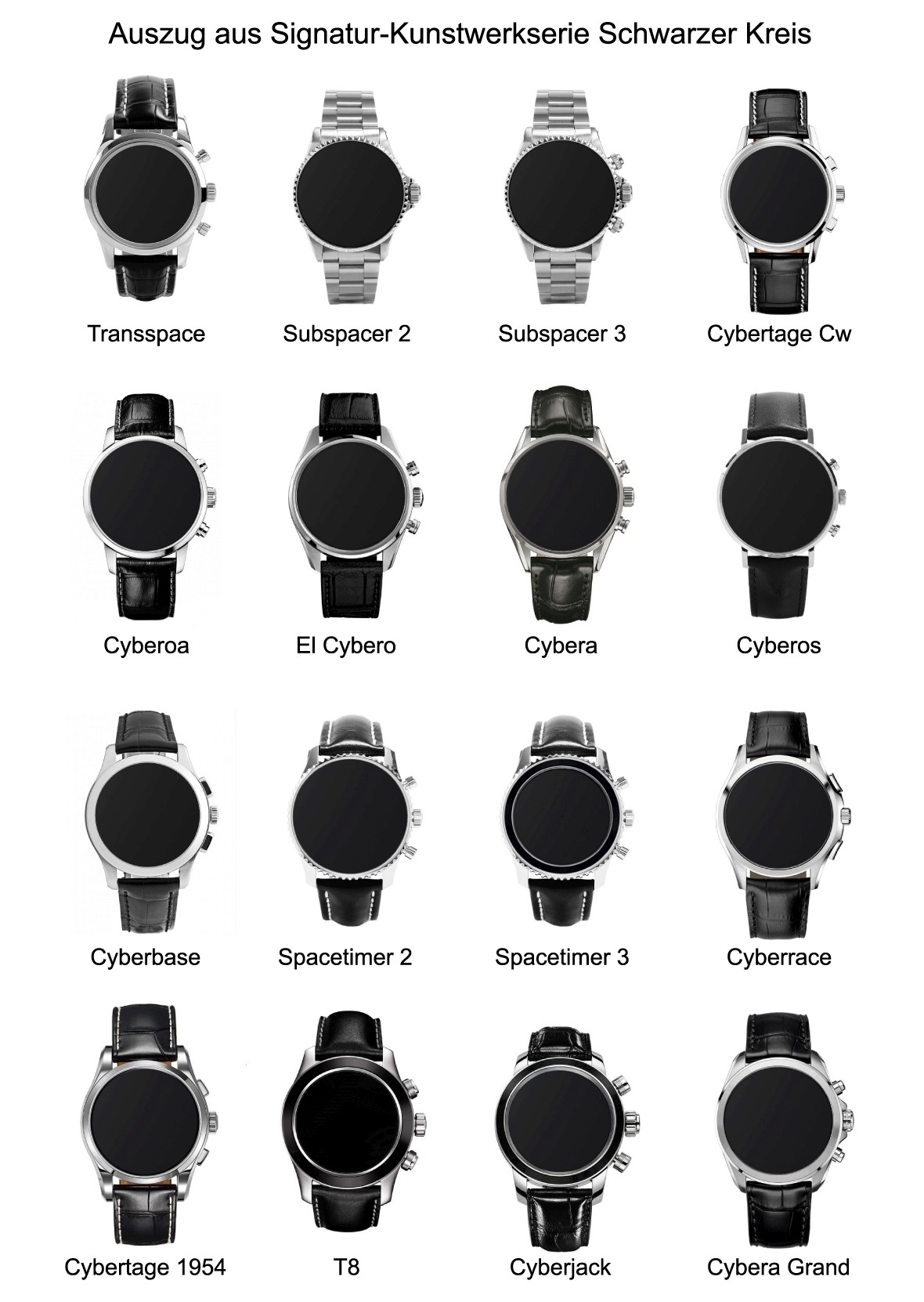
(This image will be updated, because it shows a wrong model having only a crown and some wrong designations (e.g. Subspacer 2 and Subspacer 3) used to explain the subject to an external party.)


Cyberplano DD
Durch das Ontologisches System (siehe Abschnitt 1.4.1) samt der Null-Ontologie (siehe Abschnitt 1.4.2), der Singularität (siehe Abschnitt 1.4.3) und dem Calibre (siehe Abschnitt 1.4.4) sowie durch die Ontologischen Geräte oder Ontologischen Instrumente wird von C.S. auch eine Art Schöpfungsgeschichte oder -prozess samt einer Hyle beschrieben, wie sie zum Beispiel von Robert Fludd schon diskutiert wurde (siehe Abschnitt 1.1.1), wobei im wahrsten Sinne der Worte die Null-Ontologie und Singularität die formbare Umgebung oder den 'Urstoff' von Raum und Zeit repräsentieren, der durch die menschliche, ontologische und technische Arbeit beziehungsweise Interaktion mit dem Calibre eine bestimmte Gestalt annimmt (siehe auch Abschnitt 1.1.4).
Dabei kann der als ein schwarzer Kreis oder ein schwarzes Rechteck geformte Bildschirm der Ontologischen Geräte oder Ontologischen Instrumente, am Handgelenk getragenen Computer und Smarten Uhren auch als die Hyle beziehungsweise die Null-Ontologie und die Singularität oder eben als ein schwarzes Loch interpretiert werden, in dem Raum und Zeit ineinander übergehen (siehe noch einmal Abschnitte 1.1.1 und 1.1.2).
On the basis of this overall concept and also the many further properties not reproduced here, the ontologic devices or ontologic instruments can also be regarded and even used as, so to say, digital version of an alethiometer (see once again secton 1.1.4), because an Ontologic System has not only a null ontology and is made as a singularity according to a hyle, but in addition is
- consistently verified,
- carrying the proves of correction with its executions, and
- following the accepted phyiscal theories.
But for this purpose it is indispensable that the ontologic instruments have to be operated exactly like the Golden Compasss, to get the correct results.
The reference to the OntoVerse, which is comprising the so-called cyberspace as well (see section 1.4.5), and also to the field of cybernetics can be recoginzed at many of the multimedia works of art respectively ontologic instruments of C.S., that start with the string "Cyber".
1.5 Other Works
Of course, the works of C.S. also serve as a source of inspiration for other persons and corporations.
1.5.1 Beat Haldimann
Also known is doubtlessly the so-called sculpture "H9 Reduction" of Beat Haldimann of the year 2012, which is obviously derived from the multimedia work of arts, specifically the Ontologic System and its applications, and from other works of C.S. as well, and is designated by the watchmaker as work of art as well and also (in the meantime) as "schwarzes Loch am Handgelenk==black hole on the wrist", because the "H9 Reduction" has no indicators and reflects by its three elements of the watch movement at the back side together with its larger circular case the logo of Ontologics as well as the three indicators of the Golden Compass (see section 1.1.4) and the 3cubed3 theme of C.S..
But with the multimedia work of art discussed here, wearable device respectively ontologic instrument "Cyberplano" C.S. has chosen in contrast to the 3-dimensional design of the so-called sculpture "H9 Reduction" without limits of the multidimensionality of the foundational concept of a 2-dimensional design, as it can be recognized on the original images, to depict through this the creation process of the space and the space time hereby as well.
In addition, the surface (of the display) referred to as blackened area by viewers make the reference to the painting "Schwarzer Kreis==Black Circle" amongst others and in this way to the art movement Suprematism and to further works of art of Kasimir Malewitsch and others (see once again sections 1.1.1 and 1.1.2 and also 1.4.6).
1.5.2 Other Wristwatches
Also, mechanical wristwatches reflect the logo of Ontologics as well as the 3cubed3 theme by having arranged on the front side three gears and a larger three-spoke gear driven by one of these three gears.
1.6 Summary
The above summary collates certainly only a minimal fraction of the whole creation process of C.S., its description as a whole would fill several volumes with thousands of pages.
Nonetheless, the transformation of classic wristwatches by
- the addition of a computer display and an optional electronic smart wristband, specifically of the battery wristband, as well as
- the interpretation of the art object as an ontologic device or ontologic instrument, portable or wearable computer, or smartwatch, and
- the operation as an Ontologic System
more than obviously is given and clearly recognizable.
For strengthening the effect on the viewer and the expressiveness of the work of art discussed here, like the "Cyberplano", C.S. has chosen classic and widely distributed designs of mechanical wristwatches as blueprints and transformed them to ontologic devices or ontologic instruments accordingly. But thereby the recognition of a specific watch or watch brand, or a specific watchmaker just was not paramount.
1.7 More Notes
For sure, the expressions of the related multimedia works of art, that are the Ontologic System (see section 1.4.1) and Ontoscope (see section 1.4.6,
- are not limited to devices with shapes and functionalities of mobile phones, wristwatches, and data glasses on the one hand, and
- comprise many more fields and their combinations and integrations as subsets than the ones discussed here on the other hand,
but are completely general.
For example, it is more than obvious that the combination or integration of the fields of
- horology and
- Artificial Intelligence (AI)
is included as a subset of the Ontologic System as well, as it can be understood already with the term Calibre alone (see section 1.4.4), and that every instrument used to
- measure and display the time, such as for example a clock, and
- view visual informations and images, such as for example a Virtual Reality Head-Mounted Display (VRHMD) and Mixed Reality Head-Mounted Display (MRHMD),
are included as a subset of the Ontoscope as well.
In exactly the same way as it is obvious in the case of the temporal aspects, it is also more than obvious in the case of the spatial aspects.
For example the combination or integration of the fields of
- Geographic Information System (GIS),
- GISScience, and
- CyberGIS, as well as
- Augmented Reality (AR),
- Virtual Reality (VR),
- Mixed Reality (MR), and
- Artificial Intelligence (AI)
is included as a subset of the Ontologic System as well, as it can also be understood already with the term Calibre alone (see section 1.4.4) and with the description of the Ontologic uniVerse (OV), and that every instrument used to
- measure, record, map, and navigate the space using depth technologies,
- scan and track spatial informations, and
- localize an object in space,
such as for example a radar, lidar, structured-light 3D scanner, 3D camera, and Time-of-Flight (ToF) camera, but also an Ontoscope,
and every system and environment used to
are included as multimedia systems and applications as well.
- foundations
- cybernetics and
- ontonics including ontologics, specifically Ontologic System (OS),
- metapher of robot head,
- multimodal, which means conceptually every kind of
- sensor,
- 2D
- 3D
- microphone,
- camera,
- altimeter,
- thermometer,
- hygrometer (moisture),
- altimeter,
- gyroscope,
- emitter and radiator
- display,
- laser,
and - actuator
- loudspeaker
- sensor,
- network computing
- distributed, cluster, grid, cloud, swarm,
- internet,
- World Wide Web (WWW),
- wired and wireless
- multimodal
- text,
- touch,
- view, gesture,
- speech, voice command,
- tactile, haptic,
- AI
- logic computing, constraing computing,
- dialog, conversational,
- self-reflecting,
- user reflecting,
- proactive,
- pervasive computing,
- wearable computing,
- etc.
